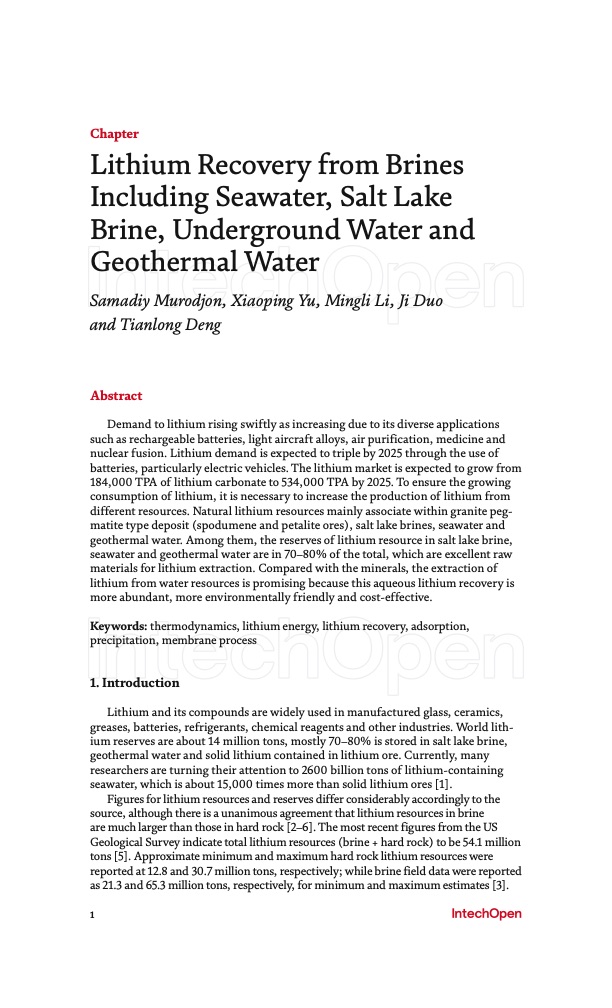
PDF Publication Title:
Text from PDF Page: 003
Chapter Lithium Recovery from Brines Including Seawater, Salt Lake Brine, Underground Water and Geothermal Water Samadiy Murodjon, Xiaoping Yu, Mingli Li, Ji Duo and Tianlong Deng Abstract Demand to lithium rising swiftly as increasing due to its diverse applications such as rechargeable batteries, light aircraft alloys, air purification, medicine and nuclear fusion. Lithium demand is expected to triple by 2025 through the use of batteries, particularly electric vehicles. The lithium market is expected to grow from 184,000 TPA of lithium carbonate to 534,000 TPA by 2025. To ensure the growing consumption of lithium, it is necessary to increase the production of lithium from different resources. Natural lithium resources mainly associate within granite peg- matite type deposit (spodumene and petalite ores), salt lake brines, seawater and geothermal water. Among them, the reserves of lithium resource in salt lake brine, seawater and geothermal water are in 70–80% of the total, which are excellent raw materials for lithium extraction. Compared with the minerals, the extraction of lithium from water resources is promising because this aqueous lithium recovery is more abundant, more environmentally friendly and cost-effective. Keywords: thermodynamics, lithium energy, lithium recovery, adsorption, precipitation, membrane process 1. Introduction Lithium and its compounds are widely used in manufactured glass, ceramics, greases, batteries, refrigerants, chemical reagents and other industries. World lith- ium reserves are about 14 million tons, mostly 70–80% is stored in salt lake brine, geothermal water and solid lithium contained in lithium ore. Currently, many researchers are turning their attention to 2600 billion tons of lithium-containing seawater, which is about 15,000 times more than solid lithium ores [1]. Figures for lithium resources and reserves differ considerably accordingly to the source, although there is a unanimous agreement that lithium resources in brine are much larger than those in hard rock [2–6]. The most recent figures from the US Geological Survey indicate total lithium resources (brine + hard rock) to be 54.1 million tons [5]. Approximate minimum and maximum hard rock lithium resources were reported at 12.8 and 30.7 million tons, respectively; while brine field data were reported as 21.3 and 65.3 million tons, respectively, for minimum and maximum estimates [3]. 1PDF Image | Lithium Recovery from Seawater Salt Lake Brine

PDF Search Title:
Lithium Recovery from Seawater Salt Lake BrineOriginal File Name Searched:
IntechOpenSamadiyBookchapter.pdfDIY PDF Search: Google It | Yahoo | Bing
Product and Development Focus for Infinity Turbine
ORC Waste Heat Turbine and ORC System Build Plans: All turbine plans are $10,000 each. This allows you to build a system and then consider licensing for production after you have completed and tested a unit.Redox Flow Battery Technology: With the advent of the new USA tax credits for producing and selling batteries ($35/kW) we are focussing on a simple flow battery using shipping containers as the modular electrolyte storage units with tax credits up to $140,000 per system. Our main focus is on the salt battery. This battery can be used for both thermal and electrical storage applications. We call it the Cogeneration Battery or Cogen Battery. One project is converting salt (brine) based water conditioners to simultaneously produce power. In addition, there are many opportunities to extract Lithium from brine (salt lakes, groundwater, and producer water).Salt water or brine are huge sources for lithium. Most of the worlds lithium is acquired from a brine source. It's even in seawater in a low concentration. Brine is also a byproduct of huge powerplants, which can now use that as an electrolyte and a huge flow battery (which allows storage at the source).We welcome any business and equipment inquiries, as well as licensing our turbines for manufacturing.| CONTACT TEL: 608-238-6001 Email: greg@infinityturbine.com | RSS | AMP |